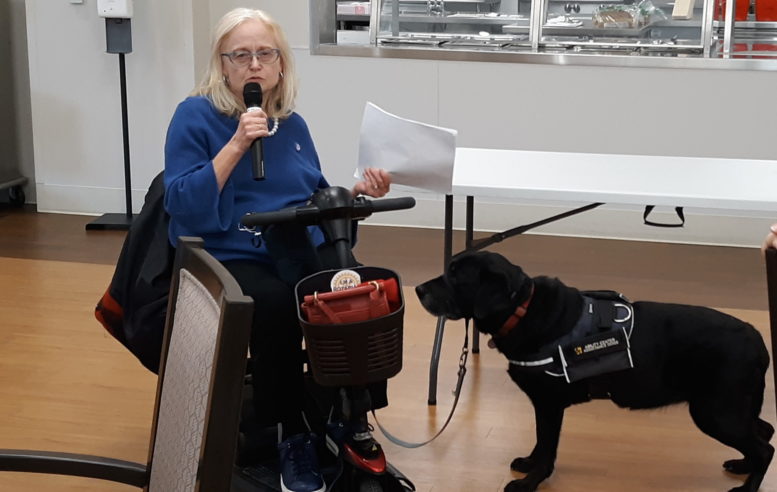By JAN LARSON McLAUGHLIN
BG Independent News
Some fur has been flying recently at the Wood County Senior Center in Bowling Green.
Discrepancies in the exact definition of a “service dog” has led to some discourse between a senior who uses a dog to alert her to health problems and others who don’t want a dog in the dining room.
Denise Niese, executive director of the Wood County Committee on Aging, would love to let sleeping dogs lie, but the lap size controversy is dogging the senior center.
During a recent meeting, Niese informed the WCCOA board members about the displeasure of some seniors and the staff’s efforts to address the concerns. She explained that after some complaints, the dog’s owner now secures her pet on a leash in the dining room, and is not allowed in the food preparation area.
Niese said the senior center must abide by the definitions and guidance of the Americans with Disabilities Act.
To calm the seniors upset about the dog’s presence in the dining room, Niese invited a representative of the Ability Center of Toledo to talk last month about her use of a service dog.
Sandy Sundermeier, of Bowling Green and an Ability Center board member, was accompanied by Reba, her licensed service dog for the past nine years, who watched intently in case her owner needed her assistance.
“Anything I drop, she’ll pick up,” Sundermeier said, demonstrating by dropping papers on the floor, and asking Reba to fetch them.
Sundermeier, who has multiple sclerosis, said Reba helps when she drops items in the bathroom, opens the refrigerator and gets water bottles, pushes buttons to open doors, assists Sundermeier as she takes off her coat, and helps push her owner’s legs into bed.
“She’s very helpful,” her owner said. “She loves her job. When she doesn’t have anything to do, she wants to make jobs for herself. She’s very sensitive to a person needing help.”
Reba, who wears a vest while she’s on the job, also keeps an eye on Sundermeier at the pool.
“She sits and watches as I swim. If someone splashes a lot, she will get up to make sure I’m OK,” Sundermeier said.
Reba underwent two years of training and is recertified as a service dog every couple years.

There are differences between service dogs and emotional support pets, Sundermeier said.
“They don’t have public access rights,” except regarding fair housing, she said of emotional support dogs. Unlike service dogs who must be trained by not-for-profit agencies, there is no specific training for emotional support pets, Sundermeier said.
“I feel bad because people with emotional support animals want them to go with them everywhere,” but they aren’t properly trained for that, she said.
Any animal can provide emotional support, but service dogs are licensed to accompany their owners anywhere. Businesses have a right to challenge emotional support animals in their establishments.
“You have every right to ask them not to. They don’t have the training. That’s not a legitimate service dog,” Sundermeier said.
The dog who attends the senior center with her owner is reportedly a cardiac service dog, which alerts its owner if she is about to suffer a cardiac issue. The initial concerns have been resolved, by requiring that the dog walk on a leash through the food service line, Niese said. But that created a secondary issue of the dog “yipping” when it wasn’t being carried.
Sundermeier cautioned that every legitimate service dog is licensed through an accredited agency. However, it is easy to get a “license” on the internet. Someone trying to pass off an emotional support dog as a service dog undermines service dog programs, she said.
However, Niese pointed out the confusion due to varying definitions from different agencies of what qualifies as a “service dog.”
Niese consulted the Wood County Health Department, which relayed the service animal rules from the Disability Rights Section of the U.S. Department of Justice.
The Americans with Disabilities Act requires state and local government agencies, businesses, and non-profit organizations (covered entities) that provide goods or services to the public to make “reasonable modifications” in their policies, practices, or procedures when necessary to accommodate people with disabilities. The service animal rules fall under this general principle. Accordingly, entities that have a “no pets” policy generally must modify the policy to allow service animals into their facilities.
Following are some of the rules:
- Under the ADA, a service animal is defined as a dog that has been individually trained to do work or perform tasks for an individual with a disability. The task(s) performed by the dog must be directly related to the person’s disability.
- The dog must be trained to take a specific action when needed to assist the person with a disability. For example, a person with diabetes may have a dog that is trained to alert him when his blood sugar reaches high or low levels. A person with depression may have a dog that is trained to remind her to take her medication. Or, a person who has epilepsy may have a dog that is trained to detect the onset of a seizure and then help the person remain safe during the seizure.
- The ADA does not require service animals to be professionally trained. People with disabilities have the right to train the dog themselves and are not required to use a professional service dog training program.
- Emotional support, therapy, comfort, or companion animals are not considered service animals under the ADA. These terms are used to describe animals that provide comfort just by being with a person. Because they have not been trained to perform a specific job or task, they do not qualify as service animals under the ADA.
- In situations where it is not obvious that the dog is a service animal, staff may ask only two specific questions: Is the dog a service animal required because of a disability? What work or task has the dog been trained to perform? Staff are not allowed to request any documentation for the dog, require that the dog demonstrate its task, or inquire about the nature of the person’s disability.
- The ADA does not require service animals to wear a vest, ID tag, or specific harness.
- The handler is responsible for caring for and supervising the service animal, which includes toileting, feeding, and grooming and veterinary care.
- Service animals must be allowed to accompany their handlers to and through a salad bar or self-service food lines. Similarly, service animals may not be prohibited from communal food preparation areas.

